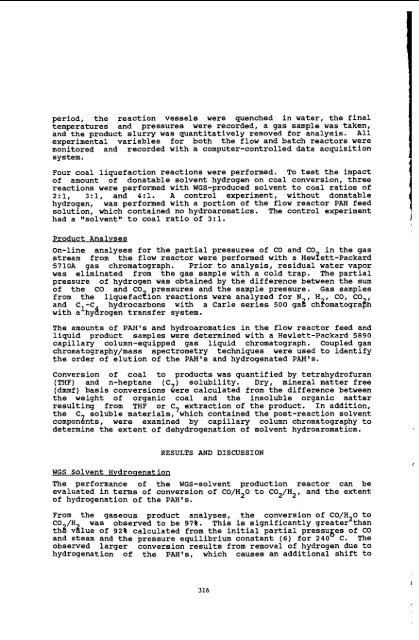Liquefaction co-processing of coal shale oil at - Argonne National ...
Liquefaction co-processing of coal shale oil at - Argonne National ...
Liquefaction co-processing of coal shale oil at - Argonne National ...
You also want an ePaper? Increase the reach of your titles
YUMPU automatically turns print PDFs into web optimized ePapers that Google loves.
period, the reaction vessels were quenched in w<strong>at</strong>er, the final<br />
temper<strong>at</strong>ures and pressures were re<strong>co</strong>rded, a gas sample was taken,<br />
and the product slurry was quantit<strong>at</strong>ively removed for analysis. All<br />
experimental variables for both the flow and b<strong>at</strong>ch reactors were<br />
monitored and re<strong>co</strong>rded with a <strong>co</strong>mputer-<strong>co</strong>ntrolled d<strong>at</strong>a acquisition<br />
system.<br />
Four <strong>co</strong>al liquefaction reactions were performed. To test the impact<br />
<strong>of</strong> amount <strong>of</strong> don<strong>at</strong>able solvent hydrogen on <strong>co</strong>al <strong>co</strong>nversion, three<br />
reactions were performed with WGS-produced solvent to <strong>co</strong>al r<strong>at</strong>ios <strong>of</strong><br />
2:1, 3:1, and 4:l. A <strong>co</strong>ntrol experiment, without don<strong>at</strong>able<br />
hydrogen, was performed with a portion <strong>of</strong> the flow reactor PAH feed<br />
solution, which <strong>co</strong>ntained no hydroarom<strong>at</strong>ics. The <strong>co</strong>ntrol experiment<br />
had a l*solventl* to <strong>co</strong>al r<strong>at</strong>io <strong>of</strong> 3:l.<br />
Product Analvses<br />
On-line analyses for the partial pressures <strong>of</strong> CO and CO in the gas<br />
stream from the flow reactor were performed with a Hewfett-Packard<br />
5710A gas chrom<strong>at</strong>ograph. Prior to analysis, residual w<strong>at</strong>er vapor<br />
was elimin<strong>at</strong>ed from the gas sample with a <strong>co</strong>ld trap. The partial<br />
pressure <strong>of</strong> hydrogen was obtained by the difference between the sum<br />
<strong>of</strong> the CO and CO pressures and the sample pressure. Gas samples<br />
from the liquefac8ion reactions were analyzed for N , H , CO, CO ,<br />
and C -C hydrocarbons with a Carle series 500 gal chlom<strong>at</strong>ogra6h<br />
with a'hy8rogen transfer system.<br />
The amounts <strong>of</strong> PAHIS and hydroarom<strong>at</strong>ics in the flow reactor feed and<br />
liquid product samples were determined with a Hewlett-Packard 5890<br />
capillary <strong>co</strong>lumn-equipped gas liquid chrom<strong>at</strong>ograph. Coupled gas<br />
chrom<strong>at</strong>ography/mass spectrometry techniques were used to identify<br />
the order <strong>of</strong> elution <strong>of</strong> the PAHIS and hydrogen<strong>at</strong>ed PAH's.<br />
Conversion <strong>of</strong> <strong>co</strong>al to products was quantified by tetrahydr<strong>of</strong>uran<br />
(THF) and n-heptane (C ) solubility. Dry, mineral m<strong>at</strong>ter free<br />
(dmmf) basis <strong>co</strong>nversions Zere calcul<strong>at</strong>ed from the difference between<br />
the weight <strong>of</strong> organic <strong>co</strong>al and the insoluble organic m<strong>at</strong>ter<br />
resulting from THF or C extraction <strong>of</strong> the product. In addition,<br />
the C soluble m<strong>at</strong>erials , 'which <strong>co</strong>ntained the post-reaction solvent<br />
<strong>co</strong>mponhs, were examined by capillary <strong>co</strong>lumn chrom<strong>at</strong>ography to<br />
determine the extent <strong>of</strong> dehydrogen<strong>at</strong>ion <strong>of</strong> solvent hydroarom<strong>at</strong>ics.<br />
RESULTS AND DISCUSSION<br />
WGS Solvent Hvdroaen<strong>at</strong>ion<br />
The performance <strong>of</strong> the WGS-solvent production reactor can be<br />
evalu<strong>at</strong>ed in terms <strong>of</strong> <strong>co</strong>nversion <strong>of</strong> CO/H20 to C02/H2, and the extent<br />
<strong>of</strong> hydrogen<strong>at</strong>ion <strong>of</strong> the PAHIS.<br />
From the gaseous product analyses, the <strong>co</strong>nversion <strong>of</strong> CO/H 0 to<br />
CO /H was observed to be 97%. This is significantly gre<strong>at</strong>er'than<br />
thg vhue <strong>of</strong> 92% calcul<strong>at</strong>ed from the initial partial pressutjes <strong>of</strong> CO<br />
and steam and the pressure equilibrium <strong>co</strong>nstant ( 6) for 240 C. The<br />
observed larger <strong>co</strong>nversion results from removal <strong>of</strong> hydrogen due to<br />
hydrogen<strong>at</strong>ion <strong>of</strong> the PAHIS, which causes an additional shift to<br />
316

















